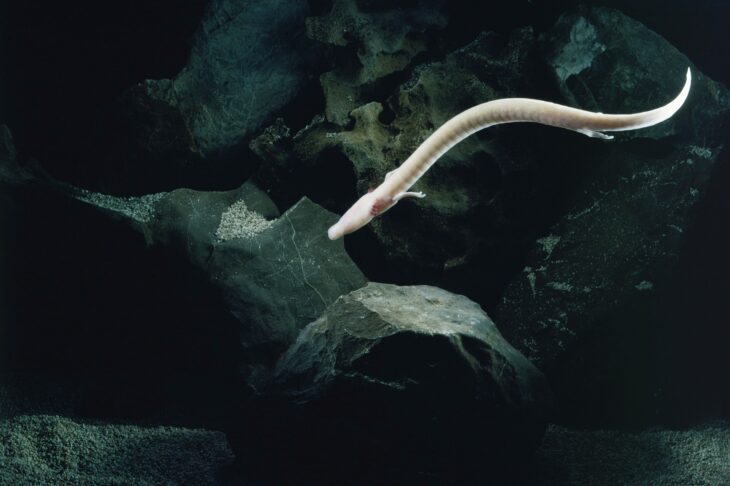Think of the words “cave salamander”. Does your brain jump to a brightly colored newt, or everyone’s favorite ugly animal, the axolotl? Similar to both of these, the olm (or Proteus anguinus) is a cave salamander that at 30 centimeters, or about a foot long, is one of the largest cave-dwelling animals.
The olm has many unique adaptations to help it survive in caves. It is completely blind and colorless, as there is no light in caves to warrant eyes and color. It also has an elongated, snake-like body, which helps it move through small cave crevasses.
The olm spends its whole life in dark caves, where the lack of sunlight means food sources are scarce. So like many cave-adapted animals, called troglobites, olms go to great lengths to make themselves more efficient. Cave-dwelling animals have many different ways of saving energy, like abandoning their circadian rhythms, or decreasing their metabolisms. But biologists have found the olm has a simpler way – it chooses not to move much.
Several scientists have studied the olm’s habits in captivity, but never in the wild. That recently changed, when researchers developed a new method of tagging olms underwater with a small plastic tag called a Visible Implant Elastomer, or VIE. The VIE allows researchers to tag amphibians like olms underwater without harming them. It even allows researchers to tell apart different specimens with the naked eye, by drawing easy to recognize markings on each tag.
A team of researchers led by Gergely Balázs from Eötvös Loránd University in Hungary used this new tagging technology to record how far olms moved in the wild. Over 4 days, researchers captured 19 adult olms in Vruljak 1, a large cave in the Balkans. They tagged the olms, and marked their location on a map of the cave. They had tagged another 7 olms 6 years earlier, when they first tested the VIE. They included these olms in a longer-term study.
The researchers waited 3 months after capturing the 19 olms, then returned to the caves and identified them. They again recorded each olm’s location to see how far they had moved. They continued the study for 2 more years, returning to the cave twice a year to locate the same olms and see how far they had moved.
The researchers concluded that the olms rarely moved around in the caves. More than half the olms moved less than 10 meters (about 30 feet) from their last location, even after 1 or 2 years between sightings. None of the olms were ever seen out of the 270 meter (about 900 feet) area where the researchers first found them, meaning they never approached the entrance of the cave, and they never strayed deeper into the cave.
The most a single olm moved was 38 meters (about 120 feet), over the course of 230 days. They even found one olm in the same location after 2,569 days – that’s 7 years and 2 weeks in the same place! The researchers wanted to know if the time in between sightings affected the distance an olm traveled, but they were surprised to find it did not.
When an animal stays in the same area for a long time, scientists refer to their behavior as extreme site fidelity. This type of immobility is rare among surface-dwellers, but it’s common among amphibians and cave animals. Even so, the scientists explained the limited movement of the olm was extreme by comparison.
The researchers hypothesized the olm can afford to remain stationary for so long because it has no natural predators. If the olm has no reason to move, it chooses not to, so it can conserve energy. An olm is so efficient at conserving energy that it only needs to eat once every several years, which makes it one of the most resilient cave animals. The researchers concluded that although cave animals are some of the hardest animals to study, the better we understand these unique creatures, the more easily we can conserve them.


